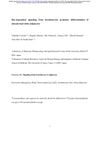Search
forLearn
1 / 1 resultsResearch
5 / 1000+ results
research To Control Site-Specific Skin Gene Expression, Autocrine Mimics Paracrine Canonical Wnt Signaling and Is Activated Ectopically in Skin Disease
The research suggests that a specific skin gene can be controlled by signals within and between cells and is wrongly activated in certain skin diseases.

research Androgen Receptor-Mediated Paracrine Signaling Induces Regression of Blood Vessels in the Dermal Papilla in Androgenetic Alopecia
Male pattern baldness is linked to higher levels of a certain receptor in the scalp, which leads to the shrinking of blood vessels and hair loss. Early treatment targeting this receptor could be more effective.

research Rac-Dependent Signaling from Keratinocytes Promotes Differentiation of Intradermal White Adipocytes
Signals from skin cells controlled by Rac proteins help turn certain precursor cells into white fat cells.

research The Topography of Fibrous Scaffolds Modulates the Paracrine Function of Adipose-Derived Mesenchymal Stem Cells in the Regeneration of Skin Tissues
The shape of fibrous scaffolds can improve how stem cells help heal skin.

research Emerging Nonmetabolic Functions of Skin Fat
Skin fat has important roles in hair growth, skin repair, immune defense, and aging, and could be targeted for skin and hair treatments.
Community Join
5 / 63 resultscommunity Looks like a real cure to the root of baldness (DHT-induced senescence) was proven earlier this year
A study that outlines the full model for androgenic alopecia (AGA) which links DHT to cellular senescence in dermal papilla cells, and suggests black chokeberry as a source of cyanidin 3-O-arabinoside polyphenol with potential anti-oxidant properties that could reverse this process. The post encourages reaching out to experts in anti-aging and longevity to research treatments involving the polyphenol.

community Minoxidil Response Bottlenecks: Why Sulfation and Transport Matter (And Where Tretinoin Fits In)
Minoxidil's effectiveness is limited by the need for sulfation and proper transport to hair follicles, with tretinoin potentially enhancing its effects by promoting enzyme activity and keratinocyte differentiation. Tretinoin may improve minoxidil's response by boosting the expression of necessary enzymes and transporters.
community Why is Minoxidil not enough for hair loss? (No fin)
Minoxidil alone is often insufficient for treating hair loss because it doesn't address the DHT-related cause. Combining it with finasteride, a DHT blocker, is generally more effective.
community The mechanism of androgenic alopecia
DHT may inhibit hair growth by affecting mitochondrial function, leading to hair follicle miniaturization. Treatments like minoxidil and PP405 may promote hair growth by altering metabolic pathways, potentially counteracting DHT's effects.
community Creatine is the opposite of minoxidil !
Creatine may counteract minoxidil's hair growth effects by closing potassium ATP channels, potentially leading to hair loss in predisposed individuals. Despite anecdotal reports, there is no conclusive evidence linking creatine to hair loss.